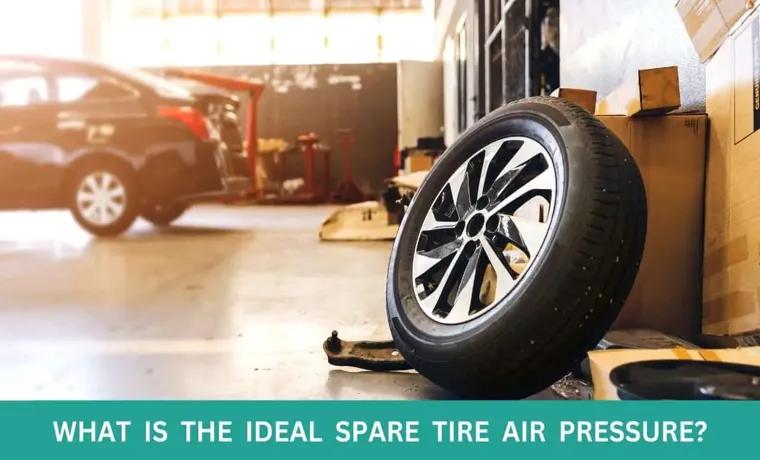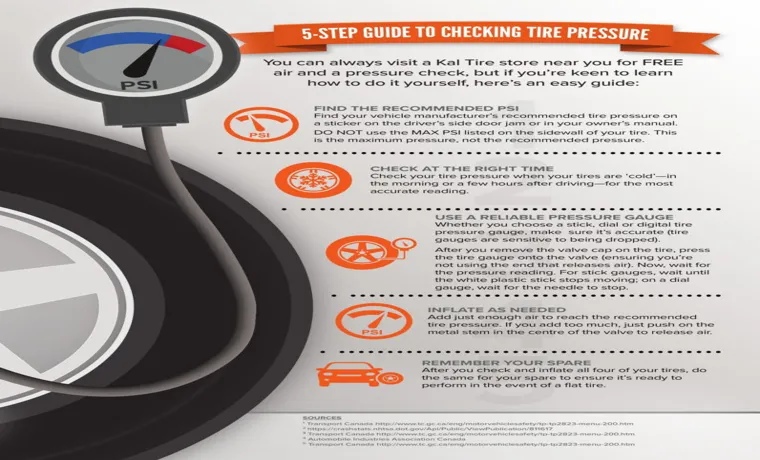Have you ever thought about the importance of spare tire pressure? You may not give it much thought or attention, but maintaining the appropriate air pressure in your spare tire can save you from being stranded on the side of the road with a flat tire. Picture this: you’re driving on a country road, and suddenly you hear a loud bang. You’ve blown a tire, and it’s completely flat.
You take out your spare tire, only to find that it’s also flat. Now what? This is why spare tire pressure is so crucial. Without the proper air pressure, your spare tire won’t be able to perform its intended function.
In this blog post, we’ll go over everything you need to know about spare tire pressure. We’ll discuss why it’s important, how to check it, and what to do if your spare tire is low on pressure. So buckle up, get ready to learn, and let’s dive into the world of spare tire pressure!
Table of Contents
Understanding Tire Pressure
When it comes to tire pressure, it’s important to not overlook your spare tire. Knowing what pressure your spare tire should be at is crucial in the event of an emergency. Typically, spare tires have a recommended pressure of 60 PSI, but it is important to refer to your car’s owner manual for the specific recommended pressure for your vehicle’s spare tire.
Make sure to check the pressure of your spare tire regularly, especially before a long road trip, to ensure that it is ready to be used in the case of a flat tire. It may seem like a small detail, but proper tire pressure can make all the difference in maintaining safety and efficiency on the road. So don’t forget to give your spare tire the attention it deserves!
The Importance of Tire Pressure
Tire pressure is a crucial component of safe and efficient driving. It refers to the amount of air inside the tires and directly affects the car’s overall performance. Understanding tire pressure is essential because it can impact the vehicle’s handling, fuel consumption, and tire lifespan.
Low tire pressure can cause tires to wear out faster and heat up, leading to blowouts on the road. Meanwhile, overinflated tires can make the car feel unstable and prone to hydroplaning. To avoid accidents caused by tire pressure, it’s important to regularly check the tires’ psi and inflate or deflate as necessary.
By doing so, drivers can ensure that their car is running smoothly, keeping them, their passengers, and other vehicles on the road safe. Remember, tire pressure is like blood pressure for a car, so maintaining it at the right level is essential for optimal performance.

How to Check Tire Pressure
Tire pressure is an essential aspect of vehicle maintenance that is often overlooked by many drivers. Understanding tire pressure is crucial, as it directly impacts the safety, performance, and longevity of your tires. Tires with low pressure tend to wear out more quickly, reducing their lifespan and affecting fuel efficiency.
On the other hand, over-inflated tires can cause poor handling and increase the likelihood of a blowout. It is therefore important to maintain proper tire pressure, which can be determined by referring to your vehicle owner’s manual or the tire’s recommended pressure, usually found on a sticker inside the driver’s side door. Using a tire pressure gauge, simply remove the valve cap and place the gauge on the valve stem.
If the reading on the gauge does not match the recommended pressure, add or release air accordingly until the proper pressure is achieved. Remember, regular tire pressure checks help ensure a safe and smooth ride on the road.
Spare Tire Pressure
Are you unsure what pressure your spare tire should be? Well, the recommended pressure for a spare tire can vary depending on the car manufacturer. That being said, it is generally suggested that you inflate your spare tire to the same pressure as the other tires on your vehicle. This will ensure optimal performance and safety on the road.
If you’re not sure what this pressure is, you can usually find it in the owner’s manual of your car. Keep in mind that spare tires are not designed for long-term use, so it’s important to replace them with a regular tire as soon as possible. So, remember to properly maintain and inflate your spare tire to ensure it’s ready to go in case of an emergency.
Manufacturer’s Recommendations
When it comes to the spare tires of your car, it’s important to keep them properly inflated to ensure optimum performance in event of an emergency. Manufacturers recommend that spare tire pressure matches the pressure of the other tires on your vehicle. This is crucial because it ensures that the spare tire is functioning properly and maintains the stability and handling of your car.
Not adhering to this recommendation can lead to imbalances in the suspension system, causing your car to handle poorly and potentially put you in danger. It’s important to remember that spare tires are not meant for long-term use and should be replaced with a regular tire as soon as possible. In summary, maintaining the recommended tire pressure in your spare tire is not only crucial to your safety, but to the overall performance of your vehicle.
Factors That Affect Spare Tire Pressure
Spare Tire Pressure Spare tire pressure is a critical issue that every driver must bear in mind. The proper inflation of your spare tire is vital, especially during unexpected emergencies when you have to replace a flat tire. Several factors can affect the pressure of your spare tire, which may compromise its efficiency when you need it most.
The temperature in your location and how long your spare tire has been stored can affect its pressure. Over time, the tire may lose air due to permeation, which can weaken the rubber materials over time. Lack of use can damage the tire’s sidewalls, leading to cracks that could cause air leaks, affecting its pressure.
It is advisable to check your spare tire pressure regularly and maintain it at the manufacturer’s recommended level. Remember that your spare tire’s pressure is an essential part of your safety kit while driving. Always make sure that you have a properly inflated spare tire in your vehicle ready to use in case of emergencies.
Ideal Pressure for Different Types of Spare Tires
Spare tire pressure is a crucial factor that affects the overall performance and safety of your vehicle. The ideal pressure for different types of spare tires varies depending on the design, size, and purpose of the tire. For instance, a compact spare tire, also known as a donut tire, should be inflated to the maximum pressure recommended by the manufacturer, usually around 60 psi.
This is because compact spare tires are designed to provide temporary relief until you can reach a repair shop. On the other hand, full-size spare tires that match the size and specifications of the regular tires should be inflated to the same pressure as the other tires, usually between 30 and 35 psi. Over-inflating or under-inflating spare tires can lead to decreased handling, poor traction, and even tire failure.
Therefore, it’s essential to check the spare tire pressure regularly and inflate them to the recommended levels for optimal performance and safety.
Maintaining Proper Tire Pressure
When it comes to maintaining proper tire pressure, it’s important to not just focus on your four main tires, but also your spare tire. Many people aren’t sure what pressure their spare tire should be at, but it’s often recommended to keep it at the same pressure as your other tires. This can typically range anywhere from 30-35 PSI, but it’s important to check your vehicle’s manual or the tire manufacturer’s recommendations for the specific make and model of your car.
Keeping your spare tire properly inflated can ensure that it’s ready for use in case of an emergency and can also help prolong the life of the tire. Don’t forget to check your spare tire’s pressure and make adjustments when needed – it could make all the difference in the event of a flat tire.
Checking Tire Pressure Regularly
Maintaining proper tire pressure is crucial for ensuring safety while driving. It is recommended that you check your tire pressure at least once a month, especially before embarking on long drives. Keeping your tires at the recommended pressure level will not only prevent accidents but also improve gas mileage and prolong the lifespan of your tires.
Low tire pressure can cause the tire to wear out faster and also make it hard to handle the vehicle on the road. On the other hand, high tire pressure can lead to poor handling and even cause the tire to burst. Hence, it is important to maintain the recommended tire pressure as stated in the owner’s manual or on the sticker attached to the driver’s side doorjamb.
You can use a tire pressure gauge to measure the pressure accurately. Do not solely rely on tire pressure monitoring systems in your car, as they do not always provide accurate readings. Keeping your tire pressure at the recommended level is an easy and inexpensive way to keep you and your vehicle safe on the road.
Inflating Tires Correctly
Maintaining Proper Tire Pressure Inflating your tires correctly is crucial to maintaining proper tire pressure, which is essential for safe and efficient driving. Driving on underinflated or overinflated tires can lead to reduced fuel efficiency, poor handling, and even tire blowouts. To ensure that your tires are inflated correctly, it is recommended to check them at least once a month and before long trips.
Use a tire pressure gauge to measure the pressure, which should match the recommended pressure listed in your car’s owner’s manual or on the tire information placard located on the driver’s side doorjamb. It is important to note that tire pressure can vary depending on the temperature outside, so be sure to check the pressure when the tires are cold. By maintaining proper tire pressure, you can improve your vehicle’s performance, safety, and longevity while also saving money on gas in the long run.
Conclusion
In a world where flat tires seem to be a rite of passage for any driver, it’s important to know what pressure your spare tire should be at. While it may not have the same responsibilities as your other tires, the spare tire still plays a crucial role in keeping you safely on the road. So, to answer the age-old question: what pressure should a spare tire be? The answer is simple – enough to keep it ready for action but not so much that it pops up uninvited.
In other words, just like in life, balance is key.”
FAQs
Why is it important to check the pressure on a spare tire?
It is important to check the pressure on a spare tire because an underinflated spare may not perform properly and can compromise the safety of the vehicle.
What is the recommended pressure for a spare tire?
The recommended pressure for a spare tire can vary by vehicle make and model, but generally it should be inflated to the pressure indicated in the vehicle owner’s manual or on the tire itself.
How often should you check the pressure on a spare tire?
You should check the pressure on a spare tire at least once a month or before long road trips, as well as after any use or impact damage.
Can you drive on a spare tire that is not at the recommended pressure?
It is not recommended to drive on a spare tire that is not at the recommended pressure, as this can affect the tire’s performance and safety.
How do you inflate a spare tire?
To inflate a spare tire, you will need a tire pressure gauge, an air compressor, and a valve stem tool to remove the valve cap. Inflate the tire to the recommended pressure and replace the valve cap.
Can you use a compact spare tire for an extended period of time?
Compact spare tires, also known as donut spare tires, are designed for temporary use only and should not be used for extended periods of time or at high speeds.
How long can a spare tire last?
A spare tire can last up to 10 years if it is properly stored and not used. However, if a spare tire is used, it should be replaced as soon as possible.



